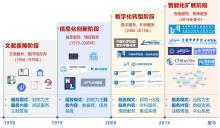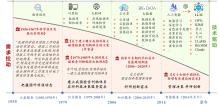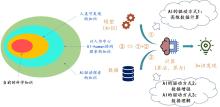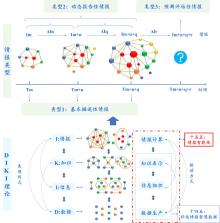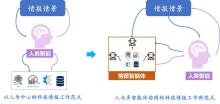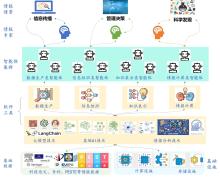| 1 |
MILOJEVIĆ S, SUGIMOTO C R, YAN E J, et al. The cognitive structure of library and information science: Analysis of article title words[J]. Journal of the American society for information science and technology, 2011, 62(10): 1933-1953.
|
| 2 |
OPENAI. Hello GPT-4o[EB/OL]. [2024-05-13]. .
|
| 3 |
TOUVRON H, LAVRIL T, IZACARD G, et al. LLaMA: Open and efficient foundation language models[J/OL]. arXiv preprint arXiv:, 2023.
|
| 4 |
GUO T C, CHEN X Y, WANG Y Q, et al. Large language model based multi-agents: A survey of progress and challenges[J/OL]. arXiv preprint arXiv:, 2024.
|
| 5 |
MESSERI L, CROCKETT M J. Artificial intelligence and illusions of understanding in scientific research[J]. Nature, 2024, 627(8002): 49-58.
|
| 6 |
YANG J, LI A, FARAJTABAR M, et al. Learning to incentivize other learning agents[J/OL]. arXiv preprint ArXiv: , 2020.
|
| 7 |
SUN W, YAN L, MA X, et al. Is ChatGPT Good at Search? Investigating Large language models as re-ranking agent[J/OL]. arXiv preprint ArXiv: , 2023.
|
| 8 |
OUYANG S Q, LI L. AutoPlan: Automatic planning of interactive decision-making tasks with large language models[C]//Findings of the Association for Computational Linguistics: EMNLP 2023. Stroudsburg, PA, USA: Association for Computational Linguistics, 2023.
|
| 9 |
XUE S Q, ZHOU F, XU Y, et al. WeaverBird: Empowering financial decision-making with large language model, knowledge base, and search engine[J/OL]. arXiv preprint ArXiv: , 2023.
|
| 10 |
GUAN Y, WANG D, CHU Z, et al. Intelligent virtual assistants with LLM-based process automation[J/OL]. arXiv preprint ArXiv: , 2023.
|
| 11 |
YAO S, YU D, ZHAO J, et al. Tree of thoughts: Deliberate problem solving with large language models[J/OL]. arXiv preprint ArXiv: , 2023.
|
| 12 |
SHINN N, CASSANO F, LABASH B, et al. Reflexion: Language agents with verbal reinforcement learning[C]// Proceedings of the Neural Information Processing Systems, New Orleans, USA: the NIPS Foundation, 2023.
|
| 13 |
LI M H, ZHAO Y X, YU B W, et al. API-bank: A comprehensive benchmark for tool-augmented LLMs[C]//Proceedings of the 2023 Conference on Empirical Methods in Natural Language Processing. Stroudsburg, PA, USA: Association for Computational Linguistics, 2023.
|
| 14 |
CHU Z, WANG Y, ZHU F, et al. Professional agents - Evolving large language models into autonomous experts with human-level competencies[J/OL]. arXiv preprint ArXiv: , 2024.
|
| 15 |
李国杰. 智能化科研(AI4R): 第五科研范式[J]. 中国科学院院刊, 2024, 39(1): 1-9.
|
|
LI G J. AI4R: The fifth scientific research paradigm[J]. Bulletin of Chinese academy of sciences, 2024, 39(1): 1-9.
|
| 16 |
TSHITOYAN V, DAGDELEN J, WESTON L, et al. Unsupervised word embeddings capture latent knowledge from materials science literature[J]. Nature, 2019, 571(7763): 95-98.
|
| 17 |
刘细文. 贯彻落实二十大精神, 开创文献情报工作的高质量发展道路[J]. 图书情报工作, 2023, 67(1): 4-8.
|
|
LIU X W. Implementing the spirit of the 20th national congress of CPC and planning the road of high-quality development of library and information service[J]. Library and information service, 2023, 67(1): 4-8.
|
| 18 |
刘细文, 付芸. 数智赋能背景下情报学研究进展[J]. 情报学进展, 2024, 15: 131-71.
|
|
LIU X W, FU Y. The research advancements in information science amidst data & AI empowerment: Data-Driven, model-driven and knowledge discovery[J]. Advances in information science, 2024, 15: 131-71.
|
| 19 |
刘细文, 孙蒙鸽, 王茜, 等. DIKIW逻辑链下GPT大模型对文献情报工作的潜在影响分析[J]. 图书情报工作, 2023, 67(21): 3-12.
|
|
LIU X W, SUN M G, WANG X, et al. Analysis of the potential impact of GPT large model under DIKIW logic chain on documentation and information services[J]. Library and information service, 2023, 67(21): 3-12.
|
| 20 |
孙蒙鸽, 韩涛, 王燕鹏, 等. GPT技术变革对基础科学研究的影响分析[J]. 中国科学院院刊, 2023, 38(8): 1212-1224.
|
|
SUN M G, HAN T, WANG Y P, et al. Impact analysis of GPT technology revolution on fundamental scientific research[J]. Bulletin of Chinese academy of sciences, 2023, 38(8): 1212-1224.
|
| 21 |
刘细文. 情报学范式变革与数据驱动型情报工作发展趋势[J]. 图书情报工作, 2021, 65(1): 4-11.
|
|
LIU X W. Paradigm transformation of library and information science and trends of data-driven information services[J]. Library and information service, 2021, 65(1): 4-11.
|
| 22 |
符福峘. 我国情报学理论体系建设的伟大成就——庆祝我国科技情报事业创建50周年[J]. 情报理论与实践, 2006, 29(4): 385-389.
|
|
FU F H. The great achievement of China in the construction of the theoretical system of information science[J]. Information studies: Theory & application, 2006, 29(4): 385-389.
|
| 23 |
关家麟, 张超. 我国科技信息事业发展的回顾与展望[J]. 情报科学, 2007, 25(1): 1-7.
|
|
GUAN J L, ZHANG C. The review and outlook for scientific and technological information undertaking of China[J]. Information science, 2007, 25(1): 1-7.
|
| 24 |
包昌火, 王秀玲, 李艳. 中国情报研究发展纪实[J]. 情报理论与实践, 2010, 33(1): 1-3.
|
|
BAO C H, WANG X L, LI Y. A record of the development of intelligence analysis in China[J]. Information studies: Theory & application, 2010, 33(1): 1-3.
|
| 25 |
中共中央文献研究室. 建国以来重要文献选编-第九册[M]. 北京: 中央文献出版社, 1994.
|
| 26 |
刘如, 吴晨生, 刘彦君, 等. 中国科技情报工作的传承与发展[J]. 情报学报, 2019, 38(1): 38-45.
|
|
LIU R, WU C S, LIU Y J, et al. History and development of scientific and technical intelligence in China[J]. Journal of the China society for scientific and technical information, 2019, 38(1): 38-45.
|
| 27 |
钱学森. 情报资料、图书、文献和档案工作的现代化及其影响[J]. 档案学通讯, 1979(5): 6-10.
|
|
QIAN X S. Modernization of information materials, books, documentation and archives and their implications[J]. Archives science bulletin, 1979(5): 6-10.
|
| 28 |
霍国庆, 汪冰. 穿越冷战的情报科学史及其启示: 理查兹“情报科学与冷战的结束”评介[J]. 情报科学, 1998, 16(2): 89-95.
|
|
HUO G Q, WANG B. The history of information technology across the cold war and its revelation - The review of Richard's information science and the end of the cold war[J]. Information science, 1998, 16(2): 89-95.
|
| 29 |
刘细文. 中国科学院文献情报中心“十四五”发展思考——基于数据、信息、知识与情报的规划框架设计[J]. 数字图书馆论坛, 2021(5): 12-16.
|
|
LIU X W. On the 14th Five-Year Plan of national science library of Chinese academy of sciences: Frameworks design based on the notion of data-information-knowledge-intelligence[J]. Digital library forum, 2021(5): 12-16.
|
| 30 |
孟广均. 中国科学院文献情报中心近40年发展概况(1978-2018)[J]. 图书馆理论与实践, 2019(8): 18-19, 31.
|
|
MENG G J. An overview of the development of the Chinese academy of sciences in recent 40 years(1978-2018)[J]. Library theory and practice, 2019(8): 18-19, 31.
|
| 31 |
刘细文. 对中国科学院文献情报中心业务改革与创新的初步认识[J]. 图书情报工作, 2002, 46(6): 11.
|
|
LIU X W. A preliminary understanding of the business reform and innovation of the document and information center of Chinese Academy of Sciences[J]. Library and information service, 2002, 46(6): 11.
|
| 32 |
张晓林. 超越图书馆: 寻求变革方向——第77届国际图联大会观感[J]. 图书情报工作, 2011, 55(21): 5-10.
|
|
ZHANG X L. Libraries beyond libraries: Seeking for transformative directions - Notes from IFLA 2011[J]. Library and information service, 2011, 55(21): 5-10.
|
| 33 |
谭晓, 靳晓宏. 数智时代情报流程模型构建研究[J]. 情报理论与实践, 2023, 46(10): 32-39.
|
|
TAN X, JIN X H. Research on the construction of intelligence process model in the digital intelligence era[J]. Information studies: Theory & application, 2023, 46(10): 32-39.
|
| 34 |
周晓英, 陈燕方, 张璐. 中国科技情报事业发展历程与发展规律研究[J]. 科技情报研究, 2019, 1(1): 13-28.
|
|
ZHOU X Y, CHEN Y F, ZHANG L. Research on the development process and law of scientific and technical information career in China[J]. Scientific information research, 2019, 1(1): 13-28.
|
| 35 |
吴晨生, 李辉, 付宏, 等. 情报服务迈向3.0时代[J]. 情报理论与实践, 2015, 38(9): 1-7.
|
|
WU C S, LI H, FU H, et al. Intelligence service towards the era of 3.0[J]. Information studies: Theory & application, 2015, 38(9): 1-7.
|
| 36 |
霍忠文, 阎旭军. “情报”、“Informagence”与“Infotelligence”——科技情报工作科学技术属性再思考[J]. 情报理论与实践, 2002, 25(1): 1-5.
|
|
HUO Z W, YAN X J. "Information", "informagence" & "infotelligence"[J]. Information studies: Theory & application, 2002, 25(1): 1-5.
|
| 37 |
KOJIMA T, GU S S, REID M, et al. Large language models are zero-shot reasoners[J]. Advances in neural information processing systems, 2022, 35: 22199-22213.
|
| 38 |
张晓林. Inside-Out & Outside-In: 图书馆服务社会高质量发展的组合模型[J]. 图书馆杂志, 2024, 43(9): 4-10.
|
|
ZHANG X L. Inside-out & outside-In: A combinatorial model for libraries' support of the high-quality development of the society[J]. Library journal, 2024, 43(9): 4-10.
|
| 39 |
李荣, 吴晨生, 董洁, 等. ChatGPT对开源情报工作的影响及对策[J]. 情报理论与实践, 2023, 46(5): 1-5.
|
|
LI R, WU C S, DONG J, et al. Study on the impact of ChatGPT on open source intelligence work and countermeasures[J]. Information studies: Theory & application, 2023, 46(5): 1-5.
|
| 40 |
GHAFAROLLAHI A, BUEHLER M J. SciAgents: Automating scientific discovery through multi-agent intelligent graph reasoning[J/OL]. arXiv preprint ArXiv: , 2024.
|
| 41 |
WANG H C, FU T F, DU Y Q, et al. Scientific discovery in the age of artificial intelligence[J]. Nature, 2023, 620(7972): 47-60.
|
| 42 |
SUH C, FARE C, WARREN J A, et al. Evolving the materials genome: How machine learning is fueling the next generation of materials discovery[J]. Annual review of materials research, 2020, 50: 1-25.
|
| 43 |
JUMPER J, EVANS R, PRITZEL A, et al. Highly accurate protein structure prediction with AlphaFold[J]. Nature, 2021, 596(7873): 583-589.
|
| 44 |
KITANO H. Nobel Turing Challenge: Creating the engine for scientific discovery[J]. NPJ systems biology and applications, 2021, 7(1): 29.
|
| 45 |
SUFI F. Generative pre-trained transformer (GPT) in research: A systematic review on data augmentation[J]. Information, 2024, 15(2): 99.
|
| 46 |
ZHANG Y, GE F, LI F Y, et al. Prediction of multiple types of RNA modifications via biological language model[J]. IEEE/ACM transactions on computational biology and bioinformatics, 2023, 20(5): 3205-3214.
|
| 47 |
ZHOU G, GAO Z, DING Q, et al. Uni-Mol: A universal 3D molecular representation learning framework[C]//Proceedings of the International Conference on Learning Representations, Kigali, Rwanda: The International Conference on Learning Representations, 2023.
|
| 48 |
NIJKAMP E, RUFFOLO J A, WEINSTEIN E N, et al. ProGen2: Exploring the boundaries of protein language models[J]. Cell systems, 2023, 14(11): 968-978.e3.
|
| 49 |
SANTACROCE M, LU Y, YU H, et al. Efficient RLHF: Reducing the memory usage of PPO[J/OL]. arXiv preprint ArXiv: , 2023.
|
| 50 |
LEE H, PHATALE S, MANSOOR H, et al. RLAIF vs. RLHF: Scaling reinforcement learning from human feedback with AI feedback[C]//Proceedings of the International Conference on Machine Learning, Honolulu, Hawaii, USA: International Machine Learning Society (IMLS), 2023.
|
| 51 |
钱学森. 科技情报工作的科学技术[J]. 兵工情报工作(1987年改名《情报理论与实践》), 1983, 6(6): 3-10.
|
|
QIAN X S. Science and technology of scientific and technological information work[J]. Information studies: Theory & application, 1983, 6(6): 3-10.
|
| 52 |
HIXSON W L. The wizards of langley: Inside the CIA's directorate of science and technology[J]. Journal of American history, 2002, 89(3): 1115-1116.
|
| 53 |
SHERMAN K. Strategic intelligence for American world policy[M]. Princeton, N.J.: Princeton University Press, 1966.
|
| 54 |
LIEW A. DIKIW: Data, information, knowledge, intelligence, wisdom and their interrelationships[J]. Business management dynamics, 2013, 2(10): 49-62.
|
| 55 |
Innovation management - Tools and methods for strategic intelligence management - Guidance: ISO 56006: 2021[S]. International Organization for Standardization [iso], 2021.
|
| 56 |
EVANS J, RZHETSKY A. Machine science[J]. Science, 2010, 329(5990): 399-400.
|
| 57 |
钱力, 刘细文, 张智雄, 等. 科技情报智慧数据: 方法、体系与应用[J]. 情报理论与实践, 2024, 47(1): 12-21.
|
|
QIAN L, LIU X W, ZHANG Z X, Et al. Smart data for scientific and technological information: Method, framework and application[J]. Information studies: Theory & application, 2024, 47(1): 12-21.
|
| 58 |
KING R, ZENIL H. A framework for evaluating the AI-driven automation of science[M]. Paris: OECD Publishing, 2023.
|
| 59 |
HUANG Y. Levels of AI agents: From rules to large language models[J/OL]. arXiv preprint ArXiv: , 2024.
|
| 60 |
LU C, LU C, LANGE R T, et al. The AI scientist: Towards fully automated open-ended scientific discovery[J/OL]. arXiv preprint ArXiv: 2408.06292, 2024
|
| 61 |
Crowdflower. Data science report[R]. 2016. San Francisco, USA: Crowdflower. https://www2.cs.uh.edu/~ceick/UDM/CFDS16.pdf.
|
| 62 |
XI Z H, CHEN W X, GUO X, et al. The rise and potential of large language model based agents: A survey[J/OL]. arXiv preprint ArXiv: , 2023.
|


